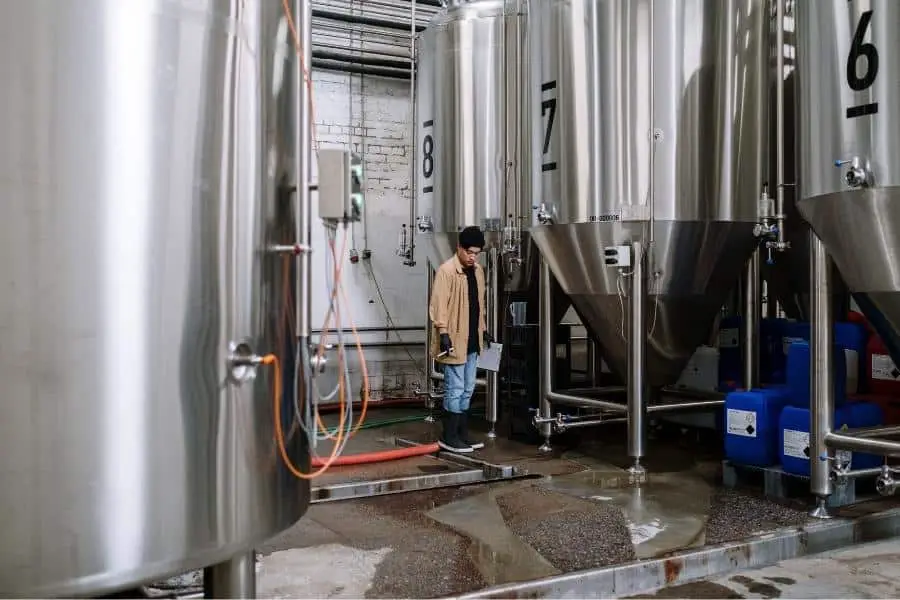If you buy something through a link in our posts, we may get a small share of the sale.
A conical fermenter is one of the most popular fermenters used by homebrewers. They are often used because they offer many advantages over other types of fermenters. So, how do conical fermenters work, and what are some of the benefits they offer?
Contents
How Do Conical Fermenters Work?
The conical fermenter uses gravity to help with the brewing process. As the wort is brewed, the heavier solids settle to the bottom of the cone while the lighter liquids rise to the top. This separation helps remove a lot of the unwanted solids that can end up in your final product. These products are often called trub which can cause off-flavors in your beer.

Additionally, the funnel shape at the bottom of the cone allows for easy removal of the trub when it comes time to transfer your beer to a secondary fermenter or bottle. This will help to ensure that your beer is as clear as possible when it is finally ready to drink.
One of the other benefits of using a conical fermenter is that it can be used for both primary and secondary fermentation. This means that you won’t have to transfer your beer to another vessel, which can save a lot of time and effort. This is more important when bottling since no siphoning is required. Instead, you can simply attach a bottling wand to the spigot at the bottom of the fermenter and bottle your beer directly from there.
Factors to Consider When Using a Conical Fermenter
This fermenter has many great advantages, and whenever possible, you should use one. However, there are a few things that you need to take into account when using this type of fermenter. The following are six important factors to consider:
Easy to Clean and Sanitize
Your fermenter should be easy to wash and sanitize. This is important because you don’t want your beer to pick up any unwanted flavors from the fermenter. Conical fermenters are often easier to clean than other types of fermenters because of their shape.
The cone at the bottom allows all of the solids to settle in one place which makes it very easy to remove them. You can also attach a sanitary valve to the bottom of the cone, making it even easier to wash. Just ensure that you clean and sanitize your fermenter before each use.
Sturdy and Reliable
If you’re planning to build a cheap fermenter, make sure that your fermenter must be made from sturdy material. This is because you don’t want it to break while your beer is fermenting. Glass and stainless steel are two of the best materials for fermenters. They are both very strong and won’t break easily.
Additionally, they are both easy to clean and sanitize, which is important for preventing off-flavors in your beer. Always use a non-rinse sanitizer when cleaning your fermenter to prevent contamination.
Has a Spigot
Your fermenter should have a spigot near the bottom. This is important because it makes it very easy to transfer your beer to a secondary fermenter or bottle. Just attach a bottling wand to the spigot, and you’re good to go.
Many brewers like this spigot since you can also use it to take hydrometer readings without removing the entire lid. This is a very convenient feature that can save you a lot of time and effort.

Benefits of a Conical Fermenter
This type of fermenter has many advantages that make it the best option for most brewers. It is the dream of every brewer to have a conical fermenter, and for a good reason. The following are some of the benefits of using this type of fermenter:
- It is very easy to cleanse and sanitize.
- It doesn’t require transferring, which can save a lot of time.
- The shape allows the yeast to settle at the bottom, making it easy to remove them.
- Most are made from high-quality materials like glass or stainless steel that won’t break easily.
- It has a spigot that makes bottling very easy and allows you to take hydrometer readings without removing the lid.
Related Questions
How Long Can You Keep Beer in Primary Fermenter?
It takes four weeks for the beer to ferment and condition in the primary fermenter. This time is enough for the yeast to do its job and for the beer to carbonate. However, you can leave your beer in the primary fermenter for up to six weeks.
What Is Cold Crashing Beer?
Cold crashing is the process of chilling your beer to near-freezing temperatures for some time. This causes the yeast to go dormant and settle out of the beer. This can help improve the clarity of your beer and make it taste smoother.
Conclusion
A conical fermenter is the best type of fermenter for most brewers. It is easy to clean and sanitize, doesn’t require transferring, and has a spigot for easy bottling. Most importantly, it is made from high-quality materials that won’t break easily.

